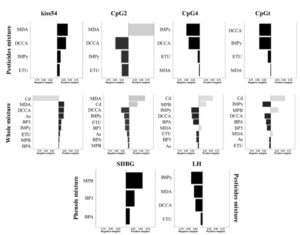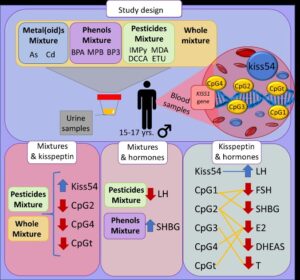INMA: “Kisspeptin: A novel effect biomarker on adolescent sex hormones caused by exposure to complex mixtures of chemical pollutants (INMA Cohort)”
28/02/2023
In the framework of the European Human Biomonitoring Initiative (HBM4EU Project) our working group has developed biomarkers for the adverse health effects of some chemicals. Of particular interest is to understand how environmental exposure affects adolescent reproductive health in order to identify risk situations and establish preventive measures.
Kisspeptins are a set of neuroactive peptides that play an important role in sexual maturation. Thus, their inclusion in epidemiological studies could help to understand how environmental pollutants alter hormone levels and sexual maturation during adolescence, a crucial period for human development.
Objective: To ascertain whether kisspeptin serum protein and DNA methylation levels are associated with exposure to several contaminants (assessed individually and as a mixture) and the reproductive hormone profile in adolescent males.
For this purpose, the levels of a set of environmental pollutants of very different origin, use, and source of exposure were quantified in the urine of adolescents aged 15 to 17 years: Three phenols (bisphenol A [BPA], methyl-paraben [MPB] and benzophenone-3 [BP3]); two heavy metals (arsenic and cadmium) and four pesticide metabolites, three insecticides (2-isopropyl-6-methyl-4-pyrimidinol [IMPy], malathion diacid [MDA] and dimethylcyclopropane carboxylic acid [DCCA]) and one fungicide (ethylene thiourea [ETU]). In addition, the concentration of kiss54 in serum and KISS1 gene methylation in whole blood were determined. Serum levels of the following sex hormones were also quantified: total testosterone (TT), estradiol (E2), sex hormone binding globulin (SHBG), dehydroepiandrosterone (DHEAS), luteinizing hormone (LH), and follicle-stimulating hormone (FSH).
Quantile G-computational was used to evaluate the impact of the mixture of contaminants, by families (phenols; metals; pesticides), and the total mixture (all quantified compounds). Linear regression models were also performed to investigate the association between each of the individual chemical contaminants with the kisspeptin protein and its DNA methylation levels. The association between kisspeptin and reproductive hormones was also assessed. All models were adjusted for variables of interest (adolescent age, waist-to-height ratio, Tanner genital stage; annual household income, the season of sample collection, and urinary creatinine levels).
We observed that exposure to the pesticide mixture and the total chemical mixture was associated with higher protein levels of kiss54 [% change (95%CI)=9.09 (3.29;15.21) and 11.61 (3.96;19.82), respectively] and lower levels of total methylation (∑CpGs). Individual MDA and DCCA concentrations were also associated with higher kisspeptin levels [% change (95% CI) 2.90 (0.32;5.56), and 1.93 (0.45,3. 43), respectively]; IMPy concentrations with lower percent methylation for sum CpGs and for CpG1 [% change (95% CI)= -0.89 (-1.73;-0.01), -1.15 (-1.96;-0.33), respectively]. BP3 and DCCA appeared, in addition, to be associated with lower total methylation (∑CpGs) [-0.53 (-1.04;-0.01) and -0.69 (-1.37;-0.01), respectively]. Adolescents with higher kiss54 concentrations (third tertile), also had higher LH levels [% change (95% CI) = 28.69 (3.75-59.63)], and those with higher CpG1, CpG2, and total CpG methylation percentages (third tertile) had lower FSH and E2 levels.
The negative correlation between serum kiss54 levels and KISS1 DNA methylation percentages places the kiss54 measure in an excellent position in the battery of biomarkers studied so far. This study highlights, on the one hand, the seriousness of the exposure of young people to environmental pollutants with the capacity to influence hormones, the variety of sources of exposure – plastics, cosmetics, and food – and the need to incorporate strategies for evaluating the effect of mixtures of pollutants, knowing that this is the real scenario in which human exposure to environmental pollutants occurs.
Figure. Effects of contaminant mixture on kiss54 (serum and methylation levels in several CpGs) and on reproductive hormones (SHBG, LH).
Reference: Rodriguez-Carrillo A, Remy S, D’Cruz SC, Salamanca-Fernandez E, Gil F, Olmedo P, Mustieles V, Vela-Soria F, Baken K, Olea N, Smagulova F, Fernandez MF, Freire C. Kisspeptin as potential biomarker of environmental chemical mixture effect on reproductive hormone profile: A pilot study in adolescent males. Sci Total Environ. 2023 Apr 10;868:161668. doi: 10.1016/j.scitotenv.2023.161668. Epub 2023 Jan 16. PMID: 36657687.
Link to the scientific article: https://pubmed.ncbi.nlm.nih.gov/36657687/
Andrea Rodríguez-Carrillo (andrearc@ugr.es). Flemish Institute for Technilogical Research (VITO); University of Antwerp (UA). Instituto de Investigación Biosanitaria (Ibs.GRANADA)
Mariana (Marieta) Fernández (marieta@ugr.es). Universidad de Granada, Centro de Investigación Biomédica. Instituto de Investigación Biosanitaria (ibs.GRANADA), CIBERESP
Carmen Freire (cfreire@ugr.es) Instituto de Investigación Biosanitaria (Ibs.GRANADA), CIBERESP


